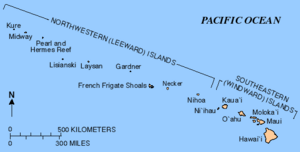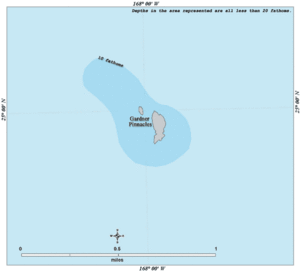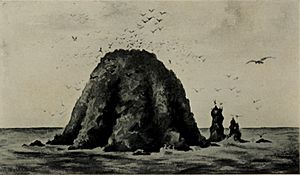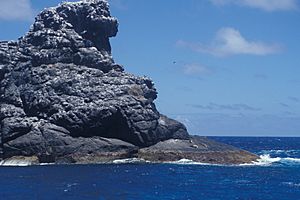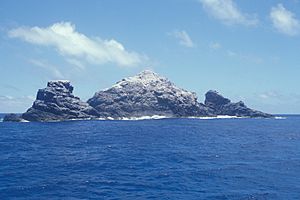Gardner Pinnacles facts for kids
The Gardner Pinnacles (also called Pūhāhonu) are two small, rocky islands in the Northwestern Hawaiian Islands. They are surrounded by a beautiful coral reef. You can find them at coordinates 24°59′56″N 167°59′58″W / 24.99889°N 167.99944°W.
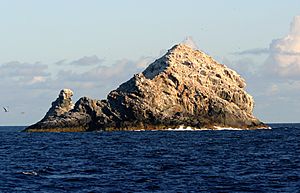
These pinnacles are about 511 nautical miles (946 km) northwest of Honolulu. They are also 108 miles (174 km) from French Frigate Shoals. The two small islands are actually what's left of a very old volcano. This volcano is thought to be the largest shield volcano on Earth!
The islands themselves are tiny, covering about 5.9 acres (24,000 square meters). The tallest part is about 170 feet (52 meters) high. But the reef around them is huge, covering more than 1,904 square kilometers (735 square miles). A whaling ship called the Maro discovered and named the Gardner Pinnacles in 1820.
Contents
History of Gardner Pinnacles
The Gardner Pinnacles were first found on June 2, 1820. An American whaler ship named the Maro, led by Captain Joseph Allen, made this discovery.
In 1859, a survey ship called the USS Fenimore Cooper precisely mapped the location of Gardner Pinnacles.
Over time, the Gardner Pinnacles became an important protected area. In 1903, they became part of the Hawaiian Islands Bird Reservation. Later, in 1940, they joined the Hawaiian Island's National Wildlife Refuge. Today, the pinnacles are part of the Papahānaumokuākea Marine National Monument, which is a large wildlife refuge.
Gardner Pinnacles was once used as a spot for helicopters to land during the Hawaiian HIRAN project. This project helped figure out the exact locations of islands for navigation. Nearby islands and reefs include French Frigate Shoals to the southeast and Maro Reef to the northwest.
Geology: Earth's Largest Volcano?
The islands of Gardner Pinnacles are made of basalt rock. This rock comes from cooled lava and is dark grey and very dense.
Scientists believe that the volcano under Pūhāhonu (Gardner Pinnacles) might be the largest single volcano on Earth. A study in 2020 suggested it contains about 150,000 cubic kilometers of rock. Most of this huge volcano is hidden underwater, buried under a ring of broken coral and other materials.
To give you an idea of its size, Mauna Loa in Hawaii is the tallest shield volcano from the seafloor to its peak. But Mauna Loa is much smaller in total volume, estimated at 83,000 cubic kilometers. The Pūhāhonu volcano is so heavy that it has caused the Earth's crust around it to sink over millions of years.
The Tamu Massif, a huge volcanic feature east of Japan, was once thought to be the largest shield volcano. However, scientists now believe Tamu Massif formed differently, along a mid-ocean ridge. This means Pūhāhonu is now considered the largest known shield volcano on Earth.
Ecology: Plants and Animals
Only one type of plant is known to grow on the Gardner Pinnacles: the succulent sea purslane. However, many different bird species have been seen here, and many of them build their nests on the islands. There are also various insect species living on the pinnacles.
The waters around the islands are full of marine life. One special animal found here is the Giant Opihi (Cellana talcosa), also known as the Hawaiian Limpet. This limpet lives in the rocky tidal areas and is not found anywhere else in the world outside the Hawaiian Islands. Many types of fish and coral also thrive in the nearby waters.
Because so many birds live on the islands, a lot of their droppings (called guano) have covered the surfaces. This gives the pinnacles a whitish look.
Some of the fish species you might find in these waters include the red lip parrotfish, doublebar goatfish, and reef triggerfish.
Naming the Pinnacles
The name Gardner comes from its discovery in 1820. Captain Joseph Allen of the ship Maro named it Gardner's Island. They also discovered Maro Reef, which is named after his sailing ship.
Besides Gardner Pinnacles, it has sometimes been called Gardner Rock or Gardner Island. The Hawaiian name, Pūhāhonu, means 'turtle surfacing for air'. This comes from pūhā meaning 'to breathe at the surface' and honu meaning 'turtle'.
See also
 In Spanish: Gardner Pinnacles para niños
In Spanish: Gardner Pinnacles para niños


